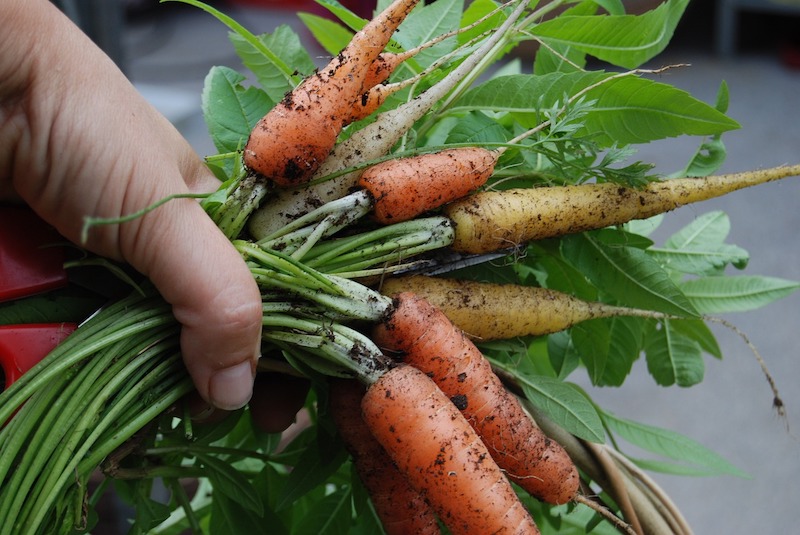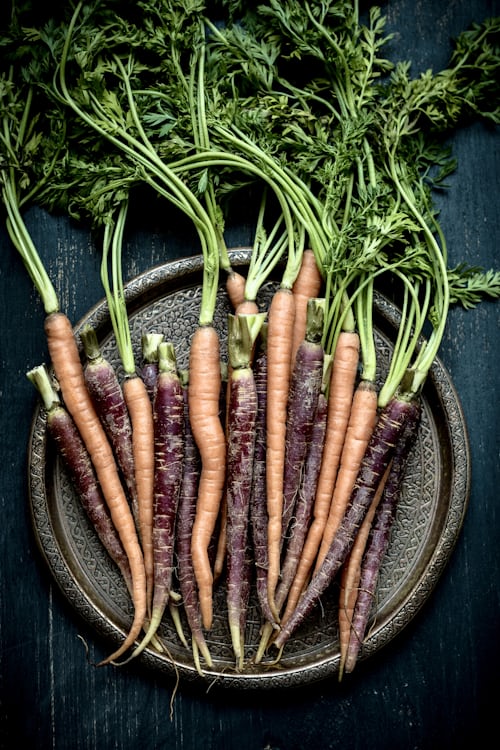Learning how to grow carrots is well worth your effort. Any gardener will tell you how homegrown carrots are just the best. I'm telling you they taste fresh, crunchy, and sweet. Especially right after the harvest.
With our weekly family consumption of carrots, I've long grown carrots in my vegetable garden. Although I still buy carrots from the market when I run out of supply, I can tell just how excellent my homegrown carrots are.
Learn how to grow carrots at home with this complete vegetable growing guide. I'm pretty sure you'll be growing more carrots after enjoying your own harvest.
How To Grow Carrots | A Complete Garden Season Growing Guide
Carrot is a staple in our diet so it's such a satisfaction to grow my own. My family gets to eat fresh, clean, and healthy carrots while I am able to save much on food expense. I know some may think growing vegetables on a regular basis is a hassle. I used to think so too but after enjoying my first harvest, I'm not going back to buying all carrots from the supermarket.
Growing vegetables have its challenges but the rewards are totally worth your effort. Whether you think you just have no time or gardening is not for you. But learn how to grow carrots and you'll grow more after tasting your first harvest. And you'll find this guide on how to grow carrots simple, you'll get yourself down and dirty right away.
When To Grow Carrots
Carrots are a cool season root crop ideal for growing in the fall and spring. For fall planting in cool regions, sow your carrot seeds 10 to 12 weeks before the first frost and 2 to 3 weeks before the last frost in spring.
Depending on your hardiness zone, you can grow carrots even later or earlier in the growing season. Grow carrots in fall and winter in hardiness zones 8 and warmer.
Varieties Of Carrots
Select a carrot variety to grow depending on your preference, soil quality, and garden size. But if you've got access to heirloom seeds or just any seed you can have for free, well and good.
If you have the ideal soil for growing carrots, then you can grow the rainbow variety. But if you're not too sure of your soil quality, you can grow smaller varieties like the little fingers or the Parisian.
Soil Requirements For Growing Carrots
Carrots grow best in a sandy, loose, and well-draining soil high in organic matter or compost. Have you seen those carrots twisted and out of shape? Those are carrots grown in soil with stones and other hard matter.
So it's important to have your soil free from debris and hard matter to stunt or impede the growth of your carrots. Putting fresh manure to the soil for planting carrots will also produce oddly shaped carrots.
Too much nitrogen in the soil apparently makes the carrot fork and grow branches all over the place.
Growing Carrots In Raised Beds
[instagram url=https://www.instagram.com/p/Bqs1FvHBvQV/ hidecaption=true width=625]
You can grow carrots in containers but if you want more carrots with the planting convenience of containers then grow them in raised beds. With a raised bed, you can apply season extending tools as high tunnels. Or protection for your crops from pests such as row covers.
This is also ideal for areas with soil unsuited for growing carrots. You won't be working in a wide area so you can work out or amend just the right amount of soil. Growing carrots in raised beds is a water saver too when using a soaker hose for your watering system.
How To Grow Carrots From Seeds
Carrot seeds are small so it's best to use a seeder or you can mix carrot seeds with sand or dried coffee grounds so you can easily sprinkle them.
- Using a hoe, dig a trench in the soil to create mounds on either side of the trenches.
- Then use a stick to draw a line on top of the mounds then sprinkle the seeds.
- Now cover the seeds lightly with sand or potting mix.
- Water lightly with the soaker hose or with a watering can along the trench.
How To Grow Carrots From Scrap
Carrots are one of the vegetables you can regrow from the tops you would usually discard. The leaves of the carrots are edible and are great in salads and vegetable stir fry. Here's how to grow carrots from scraps:
- Cut an inch off the top of the carrot.
- Take an old glass and place the carrot top or tops so they sit in the bottom.
- Then fill the glass with water up to the base of the plant or the top of the root.
- Set the glass in a lighted area but not directly in the sun.
- Lastly, watch your carrot tops grow roots and grow leaves.
Carrot Plant Care Tips
Watering, weeding, and mulching are the important carrot plant care aspect to consider. Weeds may grow as soon as you sow carrot seeds so be on the lookout for these pesky green things.
Water at least once a week to establish your carrot plants. Avoid watering excessively as they can cause odd shapes in the roots too. Mulching carrots after you thin the seedlings will retain moisture in the soil. It will also help control the weeds in your plant bed.
Companion Planting For Carrots

Growing other plants along with your carrots will not only give you a variety of vegetable harvest. It will help your carrot plants too or will let your plants benefit from each other.
Grow radishes along your carrots to prevent your soil from crusting. Growing tomatoes with your carrots are great for the shade they offer. Onions and other alliums will help prevent pests from taking over your carrots.
Herbs are also great for repelling pest such as the carrot fly. Lettuce and vegetables from the cabbage family will be beneficial to carrots too. Flowers such as marigold and nasturtiums are also great carrot plant companion.
Carrots Harvest And Storage
Carrots are best stored in the ground, so it's best to pick when ready to eat them. If you've got a loose and soil then harvesting your carrots is easy peasy. Just simply pull the roots from the soil.
If you've got a rather stubborn soil then you'll need the assistance of your gardening fork. Gently loosen the soil with your garden fork to help you pull the roots off from the soil.
However, if you've planted more and frost is catching up you can store carrots in the fridge. Remove the greens and don't wash your carrots but allow them to air dry in the sun for a few hours. Then place your carrots in plastic bags and store them in the fridge.
Check the full details of growing carrots from seeds in raised beds in this video from GrowOrganic Peaceful Valley:
There's probably no week in the house without carrots in my dishes. Say every person at home eats carrot at least five pounds a week. That amount converted to cash will be how much in a year? I used to count cost as well but now with a well-maintained vegetable garden, I'm counting the amount I've saved. Growing your own food can really save you money, but your savings will surely be doubled if you grow favorites like carrots. Grow your own food and grow staples such as your favorite carrots and learn how to grow carrots in this simple growing guide.
Have you tried on freshly harvested carrots before? Wouldn't you agree nothing taste as sweet? But if you haven't, it would be great to know you've decided to grow some of your own now. I'd be delighted to know more about it in the comments section below.
You might want to try growing some of these 21 vegetable garden plants for fall or spring growing season.
Feature image source via healthysustainableliving







1 thought on “How To Grow Carrots | A Complete Garden Season Growing Guide”
Pingback: 20 Survival Gardening Plants For Spring - Social Networks For Sale